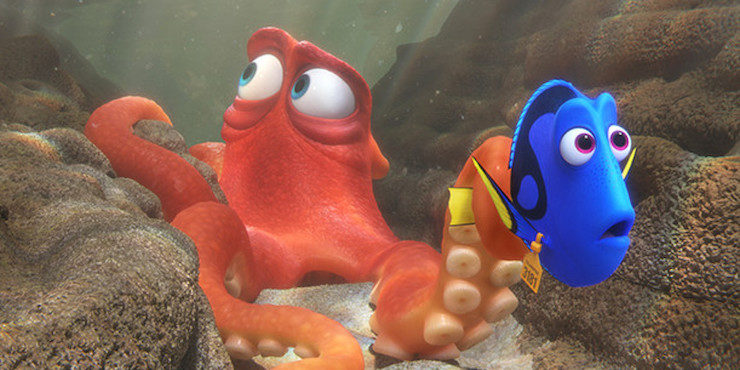Given the success of Toy Story 2, it was perhaps not surprising that Disney started making plans for a sequel to the even bigger blockbuster success Finding Nemo before that film even hit theaters. Growing tensions between Disney and Pixar during and after Finding Nemo’s release meant that Disney’s original plan was to produce and release the sequel without Pixar’s involvement. After Disney acquired Pixar in 2006, however, all Disney animation came back under the control of John Lasseter, who cancelled the plans for a Disney sequel to Finding Nemo, but kept the idea of a Pixar sequel open. If, that was, writer/director Andrew Stanton could be persuaded to come back on board.
That was a pretty big if. Not only was Stanton already fully booked with work on Wall-E, Toy Story 3 and a live action film, John Carter, he was also less than excited about the concept of churning out sequels for every single Pixar film. Sure, Toy Story 2 had been a critical and financial success, and Cars 2 had been….well, it had made money and sold quite a few toys, but Stanton—perhaps thinking of Cars 2— wanted a better reason for a sequel than “make more money.”
Eventually, Stanton had three reasons: Ellen Degeneres was eager to voice Dory, the memory-hampered fish, again; rather strong hints from Disney executives; and the financial failure of John Carter, which ensured that Stanton would not be tied up with action films for some time. By August 2012, Stanton had started coming up with story concepts; by February 2013, Disney assured eager kids everywhere that yes, yes, little Nemo would be returning in November 2015.
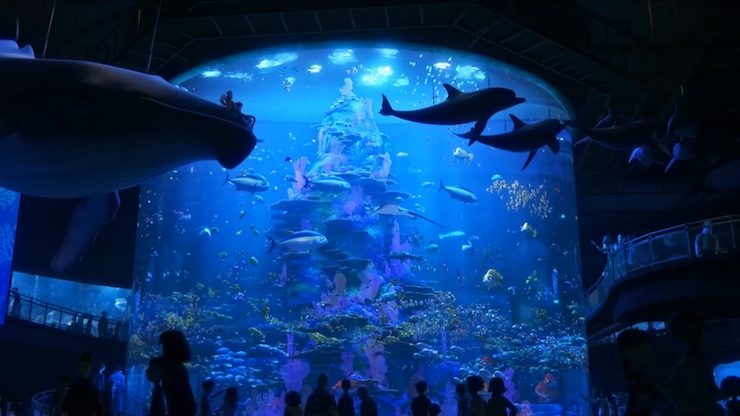
That release date ended up getting pushed back until June 2016, partly because story and production delays on another Pixar project, The Good Dinosaur, had moved that film’s release date to November 2015, and mostly because Pixar and Stanton had something special in mind for Finding Dory: completely reengineering Pixar’s rendering program, Renderman, to improve the depiction of light, and more specifically, the way light moves through water.
You can tell just how excited Pixar was about this by watching the end credits (which also include additional scenes of Hank, the color shifting octopus, blending into his surroundings), about one third of which are just credits for the Renderman program. The work, however, was worth it: as beautiful as Finding Nemo is, Finding Dory does even better work with underwater light, allowing the light to both subtly guide the story (and Dory) and have the same diffuse look that light does have beneath the water. The software’s showcase moment involves a large indoor aquarium tank lit by multiple light sources both over and surrounding the tank: the new Renderman software allowed Pixar to account for the multiple artificial light sources—in multiple colors, no less—and their diffusion through water.
And as always at Pixar, and especially with sequels, filmmakers faced another problem: story. Finding Nemo had neatly wrapped up the stories of nearly every character except for the Tank Gang—and those characters had never enjoyed the popularity of the little clownfish, Crush the turtle, or Dory. After thinking about it, however, Stanton realized that Dory remained a question mark: where had the little fish with memory issues come from? How had she learned how to speak to whales? Where had she learned her little swimming song? And with that, Finding Dory had a concept, and could move into development.
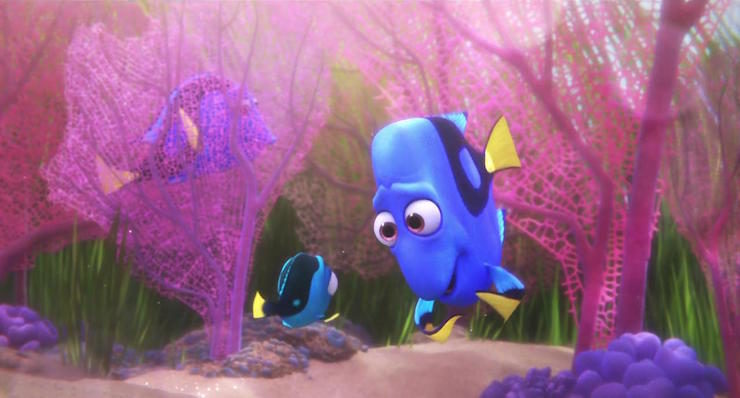
The film could not focus on only Dory. Little Nemo was far too popular to be left out of the sequel, which naturally meant that Marlin, too, had to come along, whatever his feelings about transoceanic travel. The filmmakers also agreed to feature cameo appearances from other popular Finding Nemo characters, notably Crush. And to ensure that these character appearances wouldn’t make the new film feel like a simple retread of Finding Nemo, the filmmakers decided to set most of the action in a new location: a large aquarium on the California coastline.
As the film opens, little Dory is separated from her doting parents, a rather large issue since Dory has severe short term memory loss, which eventually leads to long term memory loss. Eventually, she meets up with Marlin, leading to what is a rather confusing flashback if for some reason you missed the earlier film, and a completely unnecessary scene if you didn’t, before shifting one year forward, where Marlin and Nemo are both trying to deal with Dory being Dory—clueless, unable to remember almost anything, including important little facts like anemones sting, or where she’s from. Until something starts to jog her memory, and she remembers a single phrase: something connected to her parents.
It’s just enough to send her across the Pacific Ocean to California and a large aquarium there, followed by Marlin and Nemo. The sights and sounds of the aquarium start triggering memories of her past. It all leads to a long exploration of an aquarium/marine park from a fish point of view and one of the most massive Pixar chase scenes yet, involving a truck, an octopus who can make himself nearly invisible, several fish, a beluga, and a whale shark, all even more complicated than I’ve made it sound. Also, Sigourney Weaver becomes Dory’s new friend, in one of Finding Dory’s best running gags. Or swimming gags in this case, I suppose.
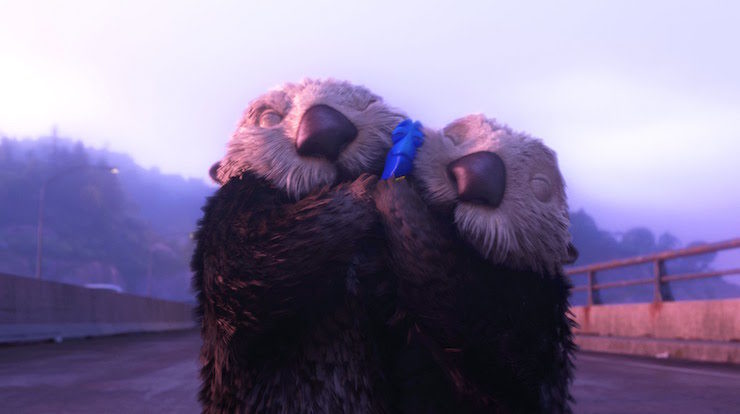
It’s entertaining, occasionally sad, and often hilarious, and I have questions. Many questions, nearly all of them about things like water temperature, salinity, and just how clearly a fish can see objects through water, glass AND the windshield of a rapidly moving truck, not to mention just how a beluga whale, using only echolocation, is able to distinguish between annoyed cops chasing down a truck driven by an octopus and regular humans pausing to see a truck driven by an octopus charging down a highway. That’s the sort of thing people pause to watch, whale, is what I’m telling you.
I would also like to know why, exactly, so many otters are willing to risk Death By Getting Squished On a Highway just because a cheerful blue fish suggested this. Ellen DeGeneres is amazingly charismatic, yes, but this charismatic? And perhaps I’m just becoming too much of a curmudgeon as I age, but as touching as the reunion is between Dory and her parents in that kelp forest, I could not help thinking that, UH, TROPICAL FISH PARENTS, POSSIBLY A COLD KELP FOREST IS NOT THE BEST PLACE TO WAIT FOR YOUR DAUGHTER, primarily because, given that Dory was sucked into quarantine more or less by accident, and wasn’t actually sick, the most logical thing to do would have been to wait for Dory back in their large tank once Dory had been medically cleared, BUT ALSO SINCE YOU ARE TROPICAL FISH, THE COLD KELP FOREST IS NOT WARM ENOUGH FOR YOU AND YOU WILL DIE frankly I am ASTONISHED that Dory turned out as well as she did.
That’s beyond the various genuine plot holes, with at least one caused by a mild confusion in marine biology: how did Destiny, a whale shark, with emphasis on shark, manage to teach Dory whale language given that—to repeat—Destiny is a shark, not a whale. On a similar note, why did Dory need to learn how to talk to whales at all, given that nearly all of the animals in this film—one dimwitted bird aside—have no problems communicating with each other or understanding Signorney Weaver?
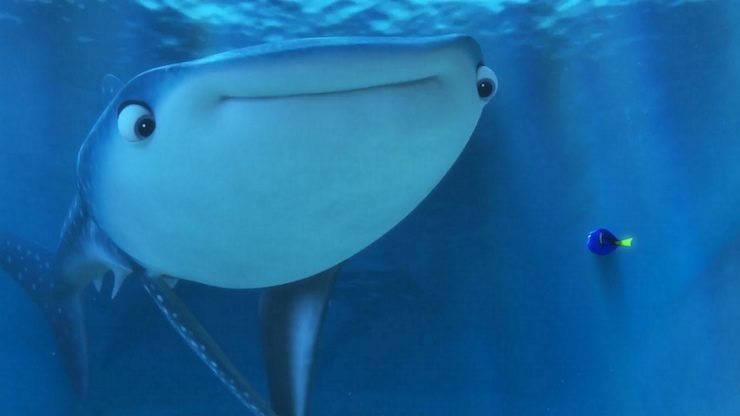
And apart from their popularity and the need to sell toys, how much did Marlin and Nemo, standouts in the last film, really need to be in this one? At times, their scenes almost feel like unwanted intrusions into Dory’s tale—though to be fair, I suspect that Dory would have forgotten them, too, had they not trekked across the Pacific Ocean to help her and remind her what she was looking for, and thus, she would not have been able to return to the Great Barrier Reef.
But all that aside, and some very Scary and Sad moments where Dory is All Alone in a Very Cold Ocean, this is for the most part a funny film, with a disability message I can embrace: you can do things your very own Dory way. And you might even, against all odds, succeed. Finding Dory avoids the simple answer of a magical cure: from beginning to end, Dory suffers from short term memory loss, and never does manage to cure this, even after bits and pieces come back to her. She even has to be reminded about the things she is remembering. And she needs help—though that’s partly because, all else aside, she’s also a fish who needs water to live, which makes moving through the various tanks in the Marine Life Institute rather difficult. When she finds herself alone again, she is terrified—she has, after all, just had a rather traumatic experience, and she’s not at all confident in her own abilities—understandably so. And yet, she manages to pull herself together, without help this time. Give her the tools she needs, and she can find her parents and free a truck load of fish.
Add in that this was only the third out of seventeen Pixar features with a female protagonist, plus a curmudgeonly octopus capable of disguising himself as pretty much anything, and some sea lions, and Finding Dory has a lot to love. Let’s face it, put Idris Elba in pretty much anything, and I’m happy. I’d be even happier if Finding Dory had more of him, especially since I’m a sucker for California sea lions, but just a few words from him goes far to reconcile me to this film.
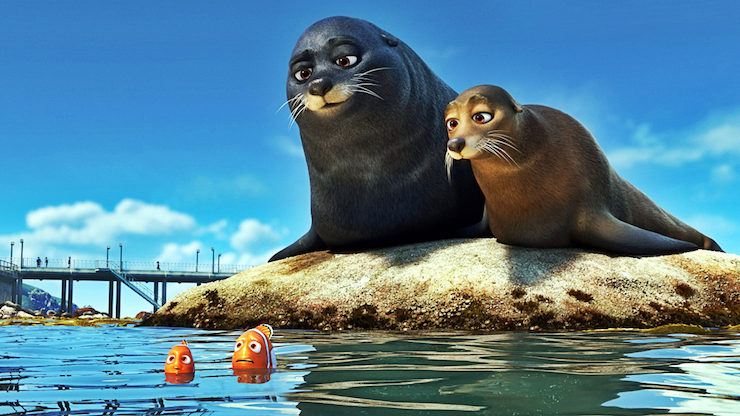
Audiences were equally reconciled. Finding Dory was an enormous success, bringing in $1.028 billion at the box office, making it Disney’s third film of 2016 to pass the $1 billion mark, after Zootopia and Captain America: Civil War. It would later be joined in this achievement by Rogue One, allowing Disney to be the first Hollywood studio to release four films each earning over $1 billion at the box office in a single year, and also allowing Disney to take the top five highest grossing films in the world spot for 2016; it was the first year since 1913 where any Hollywood studio was able to dominate all five top spots on the box office list. (The Orlando Sentinel, which covers Walt Disney World news, found this very exciting.) Disney did not quite have the ability to create and sell a toy octopus capable of completely blending into its surroundings, but they could and did sell plush octopus toys, as well as new stuffed animals based on baby Dory (this one is adorable), Bailey the beluga whale, and the otters. Disney also launched a new line of Finding Nemo/Finding Dory merchandise including mugs, clothing, tote bags and more, incorporating elements from the sequel.
It would all seem to lead to plans for a third sequel—one possibly based on finding happiness for Hank the Octopus, if I may be so bold as to make the suggestion. With “seem” as the key word here. In 2016, despite the fact that three more sequels were already either in production the (Cars 3 and Incredibles 2) or planned (Toy Story 4) Pixar suddenly announced a reversal to their GO SEQUELS GO plans, stating that after Toy Story 4, all Pixar films would be originals.
Which means that, barring a reverse of the reversal, or a television show, Finding Dory may be our last look at those fish from the reef.
At least we left them in a happy place.
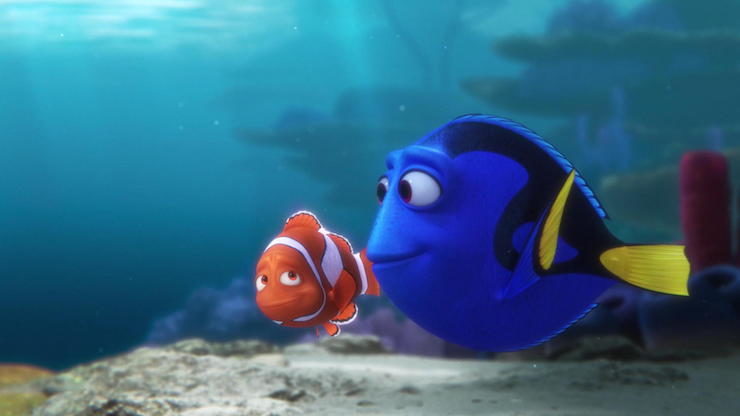
Next month, the next sequel: Cars 3.
Mari Ness lives in central Florida.










